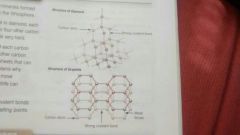![]()
![]()
![]()
Use LEFT and RIGHT arrow keys to navigate between flashcards;
Use UP and DOWN arrow keys to flip the card;
H to show hint;
A reads text to speech;
7 Cards in this Set
- Front
- Back
|
The Earth's resources |
The hydrosphere is mostly made up of water and some dissolved compounds The lithosphere is the rigid outer layer of the Earth made up of the crust and the part of the mantle just below it. It consists of a mixture of minerals and abundance of the elements silicon oxygen and aluminium. |
|
|
Chemicals of the atmosphere |
Dry atmospheric air is made from 78 percent nitrogen 21 percent oxygen nearly 1 percent argon and approximately 0.04 percent carbon dioxide |
|
|
chemicals of the lithosphere |
The lithosphere is made from the crust and the part of the mental just below it. The three most abundant elements are oxygen silicon aluminium |
|
|
Carbon in the lithosphere |

Diamond and graphite are both minerals formed from pure carbon and that is found in the lithosphere |
|
|
Chemicals of the hydrosphere |
Sea water in the hydrosphere is salty because it contains does old ionic compounds called salts |
|
|
properties of ionic compounds |
Ionic compounds have similar properties high melting points they don't conduct electricity when solid I do conduct electricity when molten or dissolved chemists develop an explanation of the structure of ionic compounds to explain these properties They have high melting and boiling points because the ions are held together by strong forces of attraction in a lattice. They don't conduct electricity when solid because the ions are fixed in place and can't move They conduct electricity when molten because the ions are free to move |
|
|
Electrolysis |
Electrolysis is the breaking down of an electrolyte using electric an electric current. the process is used to extract reactive metals from their ores because they're too reactive to be extracted by heating with carbon When an ionic compound melts electrostatic forces between the charged ions in the crystal lattice are broken down and ions are free to move When a direct current is passed through a molten ionic compound positively charged ions are attracted towards the negative electrode and negatively charged ions are attracted towards the positive electrode |

